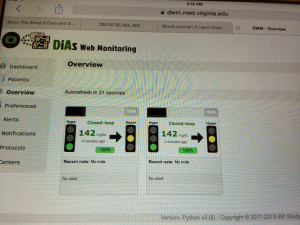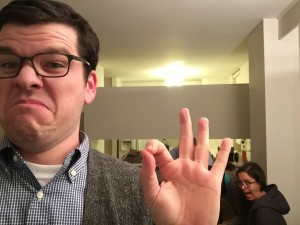An extraordinary reason to be thankful this year
Brian: Well, after an amazing five days, our artificial pancreas (AP) vacation is over.
Alecia: Boo. I have such mixed feelings now that we’ve completed the closed-loop part of the clinical trial. What was the biggest surprise for you participating in the trial (well, aside from my ruby sequin slippers)?
Brian: Well, Dorothy, hmm—biggest surprise. I’m hesitant to say I’m surprised it worked flawlessly, but at the same time I was surprised at how readily I conceded complete control of my blood sugar to an algorithm. Until I was hooked up to the DiAs, I’m not sure I fully realized what it would feel like.
I am also surprised how seriously I considered stealing the DiAs and running away with it.
Alecia: I told you we could have made a break for it! I loved REALLY seeing how everything worked. Looking at the graphs in the morning and seeing how my regular basal rate was broken up into micro-boluses was pretty incredible. I didn’t understand that part of it before the trial. Looking at an entire night’s worth of data in the morning and seeing how the algorithms gave either more or less insulin in such small amounts that kept my glucose levels steady was a true eye-opener.
I was also surprised how many people, beyond the team in the next room, were monitoring us. Doctors involved in many parts of this study were checking in and watching our numbers! Amazing.
Brian: I know! Aside from those in the rooms with us, there were people watching us remotely!
On the last night, my blood sugar was cruising down to the low range when we turned on the closed-loop; it coasted down to 80 mg/dL then slowly rose right back up to the low 100s. I can’t impress upon everyone enough how well this technology works right now. It makes me want to work and fundraise harder because our trial data isn’t enough—we need so much more.
How has this impacted how you feel about your T1D future? What does this mean for Alecia Wesner as a person with T1D, a JDRF board member and fundraiser (and rock star)?
Alecia: As for my T1D future, I learned so much during each day of this trial, and I want that to continue. Getting an inside glimpse of the technology working on my own body was breathtaking. The industrial designer aspect of my life makes me want to talk to all the developers about the software involved in our study. I would LOVE to be involved in future steps with the AP however I can.
I’ve also realized that more data needs to be collected through clinical trials. As a person with T1D, I saw firsthand how differently our bodies reacted to different types of carbohydrates and fats and how our insulin requirements varied. YET, at night, the AP kept us both in range. There was a night one of the doctors snapped a photo of the screen they were watching us on. Our blood glucose levels were the exact same number.
 When it comes to my role with JDRF, I’m more encouraged than ever to see the AP become a reality through fundraising for grants and advocacy. Sharing our incredible experience is vital to future progress.
When it comes to my role with JDRF, I’m more encouraged than ever to see the AP become a reality through fundraising for grants and advocacy. Sharing our incredible experience is vital to future progress.
Brian: I am so encouraged. And with Thanksgiving coming up, I’m so thankful for those at JDRF and UVA and Mt. Sinai and everywhere else who are working tirelessly on this stuff. I am thankful that I got to participate. And I am thankful that I got to do this with such a good friend, who came to the trial with plush pancreases for us.
 Alecia: It is heartwarming to see the dedication of all the people involved in these trials who are bringing this technology to fruition. The UVA and Mt. Sinai teams, the programmers, and especially JDRF are really making this happen. Like you, I too am grateful for this adventure. I also am so very thankful to have you, as my buddy, there at the same time and that we got to share this experience. I also may start Skyping with your parents.
Alecia: It is heartwarming to see the dedication of all the people involved in these trials who are bringing this technology to fruition. The UVA and Mt. Sinai teams, the programmers, and especially JDRF are really making this happen. Like you, I too am grateful for this adventure. I also am so very thankful to have you, as my buddy, there at the same time and that we got to share this experience. I also may start Skyping with your parents.
Brian: Only if I get to Skype with your dog.
Read Brian and Alecia’s previous blog posts.
Two “lat rats” discuss their upcoming artificial pancreas trial
The best interrupted night’s sleep ever
JDRF’s Clinical Trials Connection provides people affected by type 1 diabetes (T1D) and its complications with up-to-date information on clinical trial participation opportunities.
Clinical Trials Connection is an online service that allows you to “opt-in” to get information about trials, and access to them. It contains information about all currently active diabetes trials in the U.S and U.K. Based on the criteria you choose, the connection provides you with information about selected trials and how to contact the researchers conducting them. You can also choose to receive regular updates so that you’ll know when new trials that meet your criteria become available. If you find a trial that interests you, you can discuss it with your doctor and also contact the trial’s primary investigator with any questions or concerns.